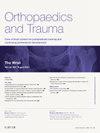Tibial shaft fractures: current concepts
Q4 Medicine
引用次数: 0
Abstract
In the adult population, tibial shaft fractures make up a significant portion of both closed and open long bone fractures. These injuries are often associated with high-energy trauma and have considerable financial impact on healthcare resources. Hence, it is crucial that these injuries are appropriately managed to provide optimal patient outcomes. The OTA/AO classification is frequently used to describe these fractures and are used in conjunction with the Gustilo–Anderson classification when open fractures are present. Along with conventional radiographs, modern imaging techniques such as computed tomography should be considered given their associations with intra-articular fractures. Primary treatment strategies aim to minimize further insult to soft tissues surrounding the fracture, prevent and/or recognize compartment syndrome, re-establish limb alignment and allow for early mobilization. Closed fractures may be treated conservatively or surgically, while open fractures require surgical intervention, sometimes in multiple stages. Postoperative care, including rehabilitation and weight-bearing guidelines, depends on injury severity and fracture type. Although scoring systems for fracture healing exist, specific validated functional outcome measures for tibial fractures are lacking. This review is aims to re-visit basic concepts and provide updates in the management of tibial shaft fractures.
胫骨干骨折:目前的概念
在成人人群中,胫骨干骨折在闭合性和开放性长骨骨折中都占很大比例。这些损伤通常与高能创伤有关,对医疗资源有相当大的经济影响。因此,对这些损伤进行适当的管理以提供最佳的患者结果是至关重要的。OTA/AO分类通常用于描述这些裂缝,当存在开放性裂缝时,与gustillo - anderson分类结合使用。考虑到现代成像技术如计算机断层扫描与关节内骨折的关系,除了传统的x线摄影外,还应考虑使用现代成像技术。主要治疗策略旨在尽量减少对骨折周围软组织的进一步损伤,预防和/或识别筋膜间室综合征,重建肢体对齐并允许早期活动。闭合性骨折可以保守治疗或手术治疗,而开放性骨折需要手术干预,有时需要分多个阶段。术后护理,包括康复和负重指导,取决于损伤严重程度和骨折类型。虽然已有骨折愈合的评分系统,但目前还缺乏针对胫骨骨折的具体有效的功能结果测量方法。这篇综述的目的是重新访问的基本概念,并提供最新的治疗胫骨干骨折。
本文章由计算机程序翻译,如有差异,请以英文原文为准。
求助全文
约1分钟内获得全文
求助全文
来源期刊

Orthopaedics and Trauma
Medicine-Orthopedics and Sports Medicine
CiteScore
1.00
自引率
0.00%
发文量
57
期刊介绍:
Orthopaedics and Trauma presents a unique collection of International review articles summarizing the current state of knowledge and research in orthopaedics. Each issue focuses on a specific topic, discussed in depth in a mini-symposium; other articles cover the areas of basic science, medicine, children/adults, trauma, imaging and historical review. There is also an annotation, self-assessment questions and a second opinion section. In this way the entire postgraduate syllabus will be covered in a 4-year cycle.
 求助内容:
求助内容: 应助结果提醒方式:
应助结果提醒方式:


